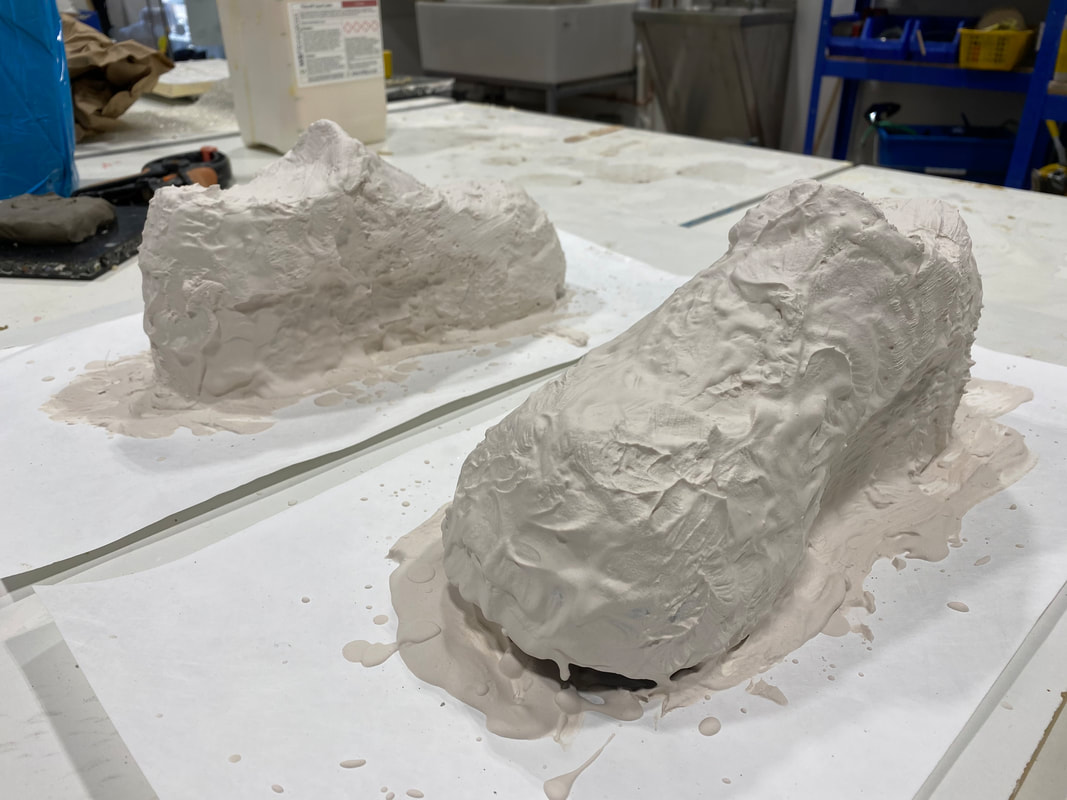Concrete shoes,
13.10.20- 19.10.20
13.10.20- 19.10.20
Click here for some reflections on 2.12.20 Working with concrete
19.10.20
Third time lucky! It took three different attempts to finally cast a pair of my shoes but it was well worth it; I am really pleased with them.
The whole process was actually a really good learning experience for me. I had the chance to make three different kinds of moulds, two plaster ones and one with alginate, which I hadn't used before. It helped me to understand the problem solving needed when considering how to make a mould and also the different ways it could be done. Sadly attempts 1 & 2 were aborted because they wouldn't actually have worked as the shoes were too complex for those kinds of moulds.
The third attempt worked! The benefit of the alginate waste mould process is that it's something I could easily do at home, and at some point I might need to if the country goes into lockdown again. The downside is that it is a waste mould, ie it has to be destroyed to release the cast. I used to think that mould making was about making identical multiples quickly and easily, until Gareth said it's more about transformation. That sounds much more interesting to me and much more aligned with my work. The idea that this process has transformed a discarded pair of old leather flatform shoes into a pair of quirky concrete sculptures is much more thrilling. It's definitely a process I'll use again.
I have reflected here about using shoes generally in art and about my shoes and embodiment in my work. Real shoes as part of an art installation have one set of meanings; cast concrete shoes have another range of meanings. This particular pair are impossible, in that they are unwearable, and even if they were technically wearable they would be too heavy to wear and incredibly uncomfortable. They're like dead shoes. I think they still speak of absence, like real shoes, but they are uncanny...familiar, yet not quite as they should be, also, beautiful but completely pointless.
Third time lucky! It took three different attempts to finally cast a pair of my shoes but it was well worth it; I am really pleased with them.
The whole process was actually a really good learning experience for me. I had the chance to make three different kinds of moulds, two plaster ones and one with alginate, which I hadn't used before. It helped me to understand the problem solving needed when considering how to make a mould and also the different ways it could be done. Sadly attempts 1 & 2 were aborted because they wouldn't actually have worked as the shoes were too complex for those kinds of moulds.
The third attempt worked! The benefit of the alginate waste mould process is that it's something I could easily do at home, and at some point I might need to if the country goes into lockdown again. The downside is that it is a waste mould, ie it has to be destroyed to release the cast. I used to think that mould making was about making identical multiples quickly and easily, until Gareth said it's more about transformation. That sounds much more interesting to me and much more aligned with my work. The idea that this process has transformed a discarded pair of old leather flatform shoes into a pair of quirky concrete sculptures is much more thrilling. It's definitely a process I'll use again.
I have reflected here about using shoes generally in art and about my shoes and embodiment in my work. Real shoes as part of an art installation have one set of meanings; cast concrete shoes have another range of meanings. This particular pair are impossible, in that they are unwearable, and even if they were technically wearable they would be too heavy to wear and incredibly uncomfortable. They're like dead shoes. I think they still speak of absence, like real shoes, but they are uncanny...familiar, yet not quite as they should be, also, beautiful but completely pointless.



